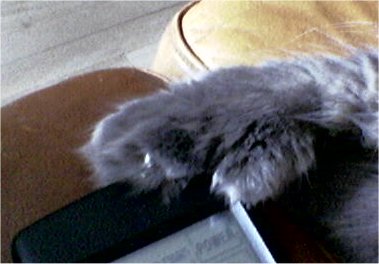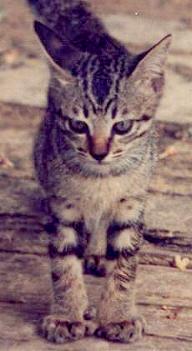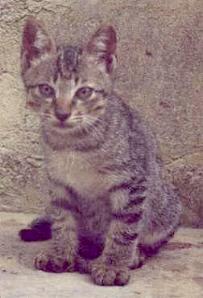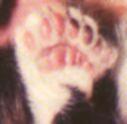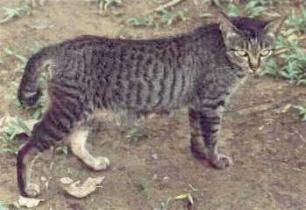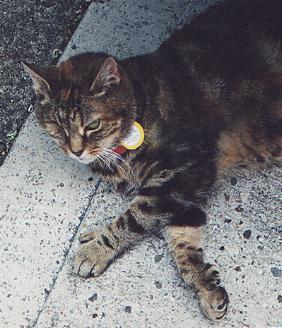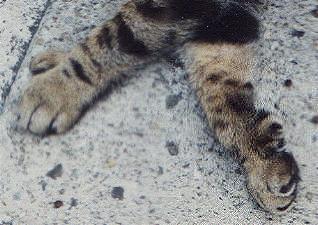About Polydactyl cats
Because Sebasco's Louie has more toes than normal on his front legs a natural interest in gathering more information about the phenomena started. Lots of things has been published on the internet about this. Much of it seems to be a copy of or similar to an article written by Sarah Hartwell. Below is a slightly shortened version of the given paper. The full article can be found here.
|
|
|
The right front paw of Louie |
Polydactyl Cats
Written and Copyright 2001-2004 by Sarah Hartwell
Shortened and republished with permission by Claus Løppenthien
- What is polydactyly?
- An all-american trait or an american conceit
- The gene(s) of polydactyly
- The 'bad' form of polydactyly
- Minor problems with polydactyly
- Polydactyly and cat fancy
- Polydactyly in big cats
- Polydatctyly records
- Polydacttyly and natural selection
What is polydactyly?
Polydactyly, polytoes or extra digits, is a common trait among cats, particularly it seems, among Celtic cats and cats on part of America's Eastern coast and South West Britain. This distribution may well be linked.
Polydactyly (six or seven toes) varies from the classic "mitten cat" through to cats which simply have more toes than normal, but no "thumb". A correspondent to the New Scientist noted that the innermost extra toes on the front paws are often opposable and some cats use them with quite startling proficiency to manipulate small objects with almost human dexterity. Some owners of polydactyl cats joke that their cats are more intelligent because of this and represent the next stage in feline evolution - the ability to open cartons and cans unaided.
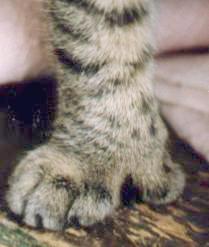 |
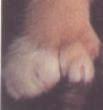 |
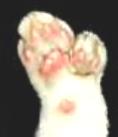 |
Polydactyl cats are known by various names - "mitten cats", "thumb cats", "six-finger cats" and "Hemingway cats". The latter is because of writer Ernest Hemingway who made his home on the small island of Key West, Florida. He shared the island with nearly 50 cats, including a 6-toed polydactyl given to him by a ship captain; the cats bred and the polydactyl trait became common, hence polydactyls are often known as "Hemingway Cats". Hemingway's colony of cats was free-breeding with the local cat population and the ratio of polydactyl cats to normal-toes cats was about 50/50. Another story suggests that the cat given to Hemingway was a female double-pawed cat and that the polydactyl cats on the island came from 19th Century ships' cats. The high rate of polydactyl cats in Boston, USA has also led to the nickname "Boston Thumb Cats". The nickname "double-pawed" cats is a misnomer since there is a specific double paw condition.
Polydactyly itself is also known as hyperdactyly or supernumary digits and occurs in many animals (including humans) as a spontaneous mutation or hereditary trait. The mode of inheritance - dominant or recessive - varies between species.
An all-american trait or an american conceit?
Some American cat lovers, cat publications and breeders (notably early advertising literature about PixieBobs) have claimed that polydactyly is unique to America. In early PixieBob promotional literature "Bigfoot is in the Building!" Brenda Weatherby and Carol Ann Brewer wrote that polydactyly first appeared in Boston in the early 17th century and that polydactyl cats are only found in North America. In actuality, polydactyl cats may have arrived in Boston from England. Polydactyly is emphatically not unique to North America. Any suggestions that polydactyl cats are not found outside of America are factually incorrect and perhaps an American conceit. The trait is found in Britain, some parts of mainland Europe and in Asia. Polydactyly is common enough in some areas of Britain for it to be almost unremarkable and I see several polydactyls per year at the Chelmsford Cats Protection rescue shelter as well as having owned a polydactyl. I found a superb bobtailed polydactyl cat in rural Malaysia (close to Kuantan) where "six-finger cats" are considered lucky. Being an unneutered tomcat, the trait would be perpetuated.
| Two polydactyl kitten from Lake Chini near Kuantan, Malaysia; the father was a bobtailed polydactyl had produced a dynasty of multi-toed kittens on local female cats. | |
An article from Cornell University, Cat Watch (1998), cited studies into polydactyl cats from the 1940´s through to the 1970´s. The study indicated that the trait may have occurred in cats taken to Boston by English Puritans during the 1600s and speculated that the mutation developed in cats already in the Boston area rather than in cats in England. The progeny of these cats may have travelled on trading ships from Boston to Yarmouth, Massachusetts and Halifax, Nova Scotia, two areas which also have a high incidence of polydactyly.
Polydactyl cats are said to be virtually non-existent in Europe, because "unusual looking cats" were destroyed due to witchcraft superstitions, practically eliminating the trait (Kelly, Larson,1993). I do not know whether Britain was included in the generic term "Europe" or whether it meant mainland (continental) Europe only. In Norway, polydactyl cats are known as "ship's cats" as the extra toes supposedly gave them better balance on ships in stormy weather; they are not uncommon and polydactyl kittens are sought after pets. Polydactyl random-bred cats have been reported in Sweden though other European cat lovers (locations not reported) had apparently never seen a polydactyl. They are not uncommon in Britain.
Polydactyl cats were considered "lucky" by sailors. Sailors also believed polydactyl cats to be superior mousers and ratters. Employed as ships' ratters and lucky mascots, they would have reached America with early British settlers hence their greater frequency in Eastern states. A disproportionately high number of "lucky" polydactyl cats, compared to normal-toed cats, would have found their way there. This would lead to a greater proportion of polydactyls than usual for a random-breeding cat population. Back in Britain, with its large cat population of which the polydactyl formed only a small part, the trait remained less common (though there have been localised pockets of higher than average incidence). There is a higher incidence of polydactyly in South-West England, possibly associated with ports from which ships set sail for the New World.
In a survey and detailed account of cats he found in Singapore in 1959, Searle had not noted any polydactyls. The only polydactyls I noted in the Malaysia/Singapore region were the Lake Chini cats.
The gene(s) for polydactyly
The gene(s) for polydactyly specifically affects the tissue formed at the very end of the limb (apical cap) of a developing embryo. This is the area where the toes will form. If the apical cap is larger than normal, extra toes will develop from it. It is worth noting that physical damage to the apical cap might also trigger the development of extra toes. Branching of the apical cap will lead to complete double paws or, if it branches early enough, to doubled limbs.
According to the late Roy Robinson in his book "Genetics for Cat Breeders", polydactyly has been officially (scientifically) recorded as early as 1868, though it had been observed earlier and seen frequently since. The distinguishing feature is the presence of extra toes, most noticeably on the front feet. Robinson explains that there is considerable variation in the number of extra toes and in how well-formed they are. The trait ranges from an enlargement of the inside digit into a "thumb" to the formation of three apparently well formed extra toes (i.e. 7 toes on the affected foot). A cat may even have different numbers of toes on each of its front feet.
The hind feet are rarely affected and are only ever affected if the front feet are also affected. I have received a report of a Maine Coon with hind foot polydactyly and apparently normal fore paws; it seems likely that it was genetically polydactyl for all four paws, but that the extra toes had not been visibly expressed in the fore paws for some reason. I also received the following report about a random-bred hind-foot polydactyl with normal front paws.
Karen Kohl's orange tabby kitten has no thumbs on his front paws and apparently normal front dew claws (described as a short splinter of a nail on the inside of his left front paw), but has 6 toes on each of his hind paws. The inside toes of each hind paw are thumb-like and have both a toe pad and an extra palm pad. One of them is retractile like his other toes and one isn't. Rufus was born in Boston in June, 2003. He and two normal-toed brothers were rescued feral kittens and probably inbred. Rufus was the only healthy one of the three. They were taken to a local cat shelter which had seen one or two cats with more toes on the back paws than on the front so Rufus isn't the only one and this form of polydactyly may be present in the local feral population. One explanation is that the polydactyly of the front paw has been suppressed by other genes. An alternative is that Rufus and other cats in that area have a mutation which affects only the hind paws - a form of polydactyly previously only seen by leopards. Boston has a high incidence of polydactyly; either due to mutations occurring there or due to "lucky" polydactylous ships' cats being taken there with early settlers.
The normal cat's front paw has 4 toes and one dewclaw (rudimentary toe or thumb which does not touch the ground) while the back paw has 4 toes. A polydactyl will usually have one or two extra toes on each foot. Most polydactyl cats have a form of pre-axial (i.e. situated in front of the axis of a limb) polydactyly with the extra toes appearing on the thumb side of the foot. The gene for Polydactyly can give rise to either extra toes or extra dewclaws. Each extra toe has its own terminal pad (fingertip) and normally an additional palmar pad and additional plantar pad. When extra toes occur on the hind paws, these are not generally dewclaw. Some owners report their cats have five toes on the hind paws, however by definition a dewclaw does not touch the ground. Possession of a hind dewclaw or extra digit is considered a throwback in cats, but is relatively common in dogs (a photo is shown below for comparison).
|
The back paws are only affected if the front paws are also affected. Unlike the front paws, there are not usually distinct "thumbs". |
In August 2002, Dominic emailed about the appearance of "thumbs" on the back feet of a polydactyl cat. Both of his polydactyl kittens appeared to have rear thumbs with claws (which were not fully retractile, probably due to the kittens' young age). The photo above is one of Zelda Annabelle's hind feet. On closer examination, the extra hind toe is not really a thumb. To be a thumb it needs to have not only a terminal pad (the "fingertip") but also a palm pad (like the palm of a person's hand or the ball of a person's thumb). A feline "thumb" sticks out at a different angle to the other toes, like the thumb of a mitten. It can be wiggled independently of the rest of the foot. Zelda Annabelle's additional hind toes are typical of polydactyl back feet - they do not have the palm-pads and they follow the curve of the foot. Because the hind paws are constructed differently to the fore paws, there are rarely true "thumbs" on the back feet (only one or two reported cases of opposable hind thumbs, but no photographic evidence).
In reviewing the various reports of polydactyly, Robinson noted that many indicate a dominant gene, but that not all cases need be due to the same mutant gene. It is possible for the exact same gene to have arisen by mutation in different localities at different times which could account for the similar heredity. Some gene loci (areas of chromosome) are more prone to mutation than are others. However, Robinson cautioned his reader that other cases of polydactyly might prove to be inherited differently.
During the 1990s, other researchers reported forms of polydactyly which they believed to be recessive. One researcher into feline curiosities suggested two different dominant forms and one recessive form all of which had subtly different effects on the structure of the paw. This was based on the sudden appearance of polydactyl cats in a population of normal-toed cats. This could only have occurred through a gene mutation or through recessive genes. Apparently the evidence among a number of random-breeding cats suggested a recessive gene for polydactyly.
Since polydactyly is seen more commonly in cats compared to other mammalian species, what is it about the cat genome (or kitten developmental processes) that makes polydactyly this common? It could simply be the location of certain gene(s) on the chromosome(s). Because of the way chromosomes are duplicated and shared out in cell division when eggs and sperm are made, some areas of chromosomes are more prone to mutation than others. These are known as mutational hot-spots. During cell division, chromosomes duplicate and the chromosome pairs are physically joined together; these are pulled apart and during separation genes can cross over from one copy to the other. Genes adjacent to the join might be affected by the separation process, resulting in small changes. This hot-spot effect could account for the spontaneous appearance of unrelated polydactyl cats in widely separated areas.
|
The father of the two Malaysian polydactyl kittens shown earlier. |
Some polydactyls (mitten cats) have double or triple dewclaws because the genes seem to give the instruction "add another digit to what is already present" rather than saying "produce 5 toes instead of 4" or "produce 6 toes instead of 4". Back in the 1960s, a cat lover in an English village reported a high incidence of polydactyl cats, mostly fathered by a local tomcat. Each generation of cats had more toes than the mother - as if the genes simply said "add another toe". Presumably there was either a limit to how many toes could be added or the tomcat left the area as the phenomenon was not reported again.
There is a similar report from the USA. Each successive generation of a colony of barn cats had more toes than the previous one. Eventually this led to crippling. The colony was severely inbred with each generation being fathered by the same polydactyl tomcat. When he disappeared, a non-polydactyl cat took his place and no further crippled kittens occurred. I also received a first hand account of crippling in later generations of polydactyl barn cats (relating to the writer's grandmother's farm). This may be the same case. Although the latter report of inbred polydactyl farm cats claimed up to 12 toes per paw, this extreme number is unlikely; 8 or 9 is generally the upper limit. The gene is variable in expression so in these colonies, paws range from mitten-paws (with a "thumb") through to double paws.
So far, veterinary literature has not confirmed the "add another toe" gene. Even in the homozygous state (which would occur in inbred colonies), the most common form of polydactyly does not appear to be detrimental to health. However, there is another gene, which resembles polydactyly, which causes severe crippling. Radial hypoplasia (RH) is discussed later in this article.
Polydactyly is probably an incomplete dominant. With a normal dominant trait, a cat either has the trait or doesn't have it. With an incomplete dominant there are different "levels" of the trait depending on whether the cat is homozygous or heterozygous for the trait. A homozygous cat shows the trait more fully than a heterozygous cat. This may have been the explanation for the apparent "add another toe" form of the gene in the English village cats. Observation suggests that the incomplete dominant is expressed only 40%-50% of the time when inherited - this concurs nicely with the 50/50 split of polydactyl/non-polydactyl in Hemingway's colony.
The suggested recessive form may also be due to incomplete dominance. The apparently "normal footed" cats would have been polydactyls with barely discernible extra toes, but whose offspring had more prominent extra toes - giving the appearance of either spontaneous mutation or recessive genes.
Because several different genotypes (genetic make-up) produced a similar or identical phenotype (physical appearance) it could be difficult to identify which cat carried which mutation. As it turns out, there are several forms of polydactyly due to several genes which produce a similar-looking trait and in the 2000s, the need to identify and isolate the various forms became crucial due to fears of a link with radial hypoplasia (Twisty Cat mutation). There was evidence for a second dominant form of polydactyly which resulted in a different form and structure to the familiar "mitten cat" form and which affects not only the paw, but the whole leg.
The form of polydactyly most commonly seen in cats is a simple autosomal (i.e. not linked to gender) dominant trait which does not affect the cat adversely and is not associated with other abnormalities. Despite suggestions of "natural snowshoes" there is no real evidence that polydactyly has any significant natural selective advantage or disadvantage. If it was disadvantageous, polydactyl cats would quickly have died out. It is simply an endearing anomaly.
It has been said that if the parent has extra toes, the kittens inherit extra toes in the same configuration as the polydactyl parent. So, if the parent has double dewclaws, the kittens have double dew claws and if the parent has an extra toe, so will the kittens. This may not be 100% true because there are undoubtedly numerous gene mutations causing polydactyly. This may be true in polydactyl breeding programs where cats are carefully matched, but in the random-breeding population, the incomplete dominance of polydactyly means the configuration is variable - and it also depends on what genes the kitten inherits from the other parent!
It is reported that in Maine Coons (where there is work to restore the polydactyl form of the breed), non-polydactyl kittens born to a polydactyl parent appear to have heavier boning in the legs and chest than kittens born to two non-polydactyl parents. In random-breeding cats, polydactyls often appear robust, but this may be due to the overall impression caused by big feet.
The 'Bad' form of polydactyly
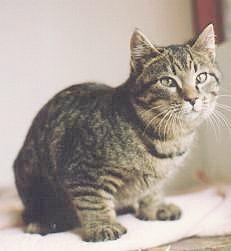
Most expressions of polydactyly are not a handicap to the cat (such as the polydactyl kitten pictured here). The exception is the gene which causes a whole spectrum of effects ranging from extra toes through to radial hypolasia/radial agenesis (the "thalidomide" or "twisty" mutation). This is the gene which causes a condition known as triphalangeal pollex-radial hypoplasia.
This is the "second dominant form of polydactyly" mentioned earlier. With this trait the pollex (thumb) has an extra joint, making it look more like a human finger than the usual rudimentary feline dewclaw. This triphalangeal (three-boned) thumb may be duplicated and sometimes the next digit is also duplicated. A cat with triphalangeal pollices (three-boned thumbs) may produce kittens with hypoplasia (underdevelopment) or aplasia (absence) of the radius, one of the two bones that make up the forearm. Hypoplasia, according to the Cornell Book of Cats, 1997, is "underdevelopment of a given tissue." So in cats with radial hypoplasia (RH) the radius in the front leg will be underdeveloped or missing.
Because the usual form of polydactyly is so variable in expression, X-rays are needed in order to distinguish between the harmless usual form of polydactyly and the form associated with RH. Some polydactyl cats without dewclaws have 5 or 6 toes all the same length. This trait is the one most often associated with RH. However, not all cats with additional same-length toes have the gene for RH. An X-ray is required to determine whether the radius is deformed in any way - if it is, the cat carries the gene for RH. The gene for RH is variable in expression (possible due to incomplete dominance/heterozygous vs homozygous state), ranging from extra toes to crippling leg deformities, hence the need to determine which norma-looking polydactyls carry the gene for RH and which carry the more usual form of polydactyly.
In a physical examination, the best way to tell the difference is to check for dewclaws. Polydactyl cats without dewclaws are disqualified from shows but may safely produce normal-footed show-quality offspring which can be used in breeding. The cats should be bred with non-polydactyl cats to keep the trait heterozygous as it appears to be the homozygous cats which are affected by RH. A number of genes in cats are less harmful in the heterozygous form, but are either crippling or lethal in the homozygous form e.g. the Manx mutation, the Scottish Fold mutation.
Minor problems with polydactyly
In general, polydactyly causes no ill-effects in cats. It is certainly not a handicap and is an anomaly (deviation from the norm) rather than a deformity. Although some owners like to have the extra toe removed for cosmetic or safety reasons, cats rarely catch the extra toe(s) on furnishings. In rare cases, nail growth can be affected, but only if the extra toe is incompletely formed and the nail bed is deformed. This can lead to a number of claw problems such as ingrowing claws, overgrown claws or "superclaw syndrome".
Overgrown claws are not restricted to polydactyl cats, but are more common in polydactyls because the extra toe is often shorter than the regular toes or it points in a slightly different directions. This means that the cat is unable to strop the extra claws on a scratching post. Unless clipped regularly, the claw can become overgrown and embed themselves in the paw pad.
Ingrowing claws grow twisted or crooked instead of growing straight with a smooth downward curve. Ingrown claws can grow into the paw pad and need either more frequent clipping or surgical removal. In the UK, such problem claws are the only time when declawing (of the affected toes only) is permitted. Ingrowing dewclaws can also occur in non-polydactyl cats where the claw grows into side of the foot.
If the claw is set in such a way that it snags on furnishings etc, it can tear and infection can set in. Nail-bed infections or nail bed damage can lead to abnormal claw growth e.g. thickening or twisting. Where the toes are cramped together, the skin between them should be checked for infection as it provides a handy undisturbed crevice for bacteria. In general, the cat's own cleaning routine should prevent this, but if the toes cannot be spread then its tongue cannot easily clean between them.
If two extra toes are fused together, the nail bed will also be fused. The claw that grows from this dual nail bed can also be fused, leading to something known colloquially as "superclaw syndrome". The fused claw or "superclaw" is thicker than a regular claw and may twist abnormally. A non-twisting superclaw is not normally painful for the cat, but because the claw is thicker and stronger than usual, it can gouge wood - and flesh - more deeply than a regular claw. If the superclaw grows twisted, there is a danger that it will become ingrown.
Where the extra toe causes repeated problems, it can be removed in a straightforward operation, but this is rarely necessary.
Polydactyly and the cat fancy
Historically, the polydactyl made up 40% of the original unregistered Maine Coon population. There are claims that the extra toes acted as snowshoes, helping these rugged cats negotiate snowy New England winters. Local folk tales claimed that these cats were fierce hunters who used their oversized paws to catch live fish, even taking fresh fish home to feed their owners! However, breed standards made no allowance for polydactyl Maine Coons and stipulated a normal foot configuration. Because polydactyly in the Maine Coon is due to the autosomal dominant gene, the trait could easily be eliminated by breeding only from non-polydactyl Maine Coons. The trait was deliberately bred out of Maine Coons and only recently have there been attempts to reinstate it.
Selection against polydactyly means the trait seems to have become associated with the term "harmful deformity" in many minds and there have even been postings on Usenet stating, quite erroneously, that "polydactyl cats almost always have some other sort of abnormality". Many cat registries happily recognise breeds defined by mutations which can have lethal or crippling effects such as spina bifida in the Manx, but refuse to permit polydactyl cats as either breeds or breed variants. Some cat enthusiasts feel that registries are right in refusing to accept polydactyl cats, fearing that breeders would try to produce cats with excessive and disabling numbers of toes on each paw. Since polydactyly doesn't work in this way and the number of toes appears to be limited, those fears are largely unfounded. In addition, breed standards could be written to define the maximum number of toes in polydactyl breeds to discourage such attempts.
Polydactyly is one of the traits of the PixieBob breed. Early write-ups on this breed suggested that only normal-footed PixieBobs would be accepted for shows. What one registry would not accept, another embraced and as well as the PixieBob and Polydactyl Maine Coons there are other polydactyl breeds being developed including the suggestion of a Hemingway Sphynx (a hairless polydactyl cat) and of developing polydactyl Munchkins a (short-legged polydactyl). The Mojave Spotted (formerly Hemingway Spotted) is being developed from Bengal x Polydactyl crosses. Several breeders in Illinois are working with a curl-eared polydactyl cat called Tulips. Tulips were originally developed in the 1990s by crossing American Curls with polydactyls, creating a harlequin patterned semi-longhaired breed. The markings, which can be any colour, are restricted to the head, down the spine, shoulders, hips and tail.
In Britain, polydactyly is still considered a serious breed fault or defect. Polydactyls can be shown but cannot receive certificates or a first prize. This prejudice is especially unfortunate for owners who wish to show polydactyl household pets. In some registries (FIFe), the prejudice is so great that polydactyl cats are banned from Cat Association shows. They feel that encouraging such abnormalities encourages inbreeding. The blunt statement is that polydactyly is a fault and cats with such defects are not allowed to be shown. This is a totally inconsistent approach since taillessness is also a fault, yet the Manx breed is perpetuated and shown. There are far fewer detrimental side-effects associated with polydactyly than there are with the Manx. The usual argument in these cases is that the Manx is a historical breed even though the polydactyly trait is equally historical. Not to mention that such bodies recognise ultra-typed or extreme Persians whose faces are so compressed that their tear ducts are distorted and their breathing may be compromised. It has to be noted that cat fancies are consistently inconsistent in their approach in such matters!
Having persuaded the American cat fancy that polydactyly is not a deformity, the trait was soon back in the feline geneticists' spotlight due to its unfortunate association with the Twisty Cat. Twisty Cats have a crippling deformity of the forelegs. They arose spontaneously when a horse-breeder began to breed Poly-Bobs, a type of cat sometimes confused with the PixieBob. Some Poly-Bob litters contained kittens with flipper-like forelegs. The mutation is occasionally found at random in the cat population, but was occurring with greater frequency in Poly-Bob litters. This was the second form of polydactyly and its effects ranged from the Poly-Bob's simple extra toes through to the Twisty Cat's vestigial or missing long bones of the leg.
Some breeders and cat lovers have become concerned that the Twisty trait was the hidden downside of polydactyly and that "all polydactyly was bad" despite the fact that perfectly healthy extra-toed cats have been around for hundreds of years. Most forms of polydactyly are no more than a harmless and attractive quirk. In polydactyl cats, it has become important to work out which ones have which gene, so that breeders working with polydactyls do not inadvertantly breed crippled kittens.
Polydactyly in big cats
Polydactyly is not limited to domestic cats. It is also found in big cats, though this is less widely reported for the obvious reason that we do not (normally) share our homes with big cats!
In 1925, The Journal of the Bombay Natural History Society published a photograph of a polydactyl leopard. It had an extra claw-bearing toe on each hind paw. Several years earlier it had published a letter regarding a leopard shot by S Eardley-Wilmot - this creature had an extra claw-bearing toe on each hind paw. In 1946, the same journal published a letter from another big game hunter who had also shot a leopard with extra toes (again fully functional with claws) on the hind feet.
Probably the most interest fact is that the leopards had the extra toes on the hind feet and not the front feet whereas in domestic cats, the hind feet are only affected if the forepaws are affected. This means that a different gene was responsible for hind-foot polydactyly in leopards ... and what can occur in a big cat might possible one day appear in domestic cats.
Polydactyl Records
The greatest number of toes EVER found on a cat is 32 (eight on each paw) reported in October 1974. This was male cat called "Mickey Mouse" owned by Mrs Renee Delgade of Westlake Village, California, USA. It is possible he had a condition known as double-paws where each paw is actually 2 fused mirror image paws; this is a different condition to polydactyly. The condition is seen in humans where there is a central thumb with four fingers either side of it (making a natural baseball catcher's glove!). There have been reports of a cat where all 4 paws are doubled. When the cat "sat to attention" it had eight paws in a row. Double-paws is a developmental defect - during early development, the tip of the limb-buds fork to produce 2 mirror-image paws which may be set at right angles to each other.
A pure-bred Siamese named "Big Foot" owned by Miss Joan Conerly of Wauchula, Florida, USA in 1978, had 26 toes (seven on each front paw, six on each back paw). His mother had 22 toes, his sister had 22 toes and a brother had 24 toes.
A female cat named "Triple" owned by Mr and Mrs Bertram Bobnock of Iron River, Michigan, USA in 1976, had 30 toes, but these are arranged on 5 legs and 6 paws! The back left leg had 2 complete lower leg extensions from the hock down, and one of those lower legs had 2 paws. This is probably a developmental defect which caused the growing tip of the limb bud to split into two and each part of the fork continued to develop into a limb. It would have forked twice, once as it got to the hock and one side would have forked again when it began to grow the paw.
In May 2002 Jennifer Beierle wrote to me about a litter of kittens whose total of toes exceeds that of Big Foot and his litter-mates. Her non-polydactyl cat got pregnant by an unknown tomcat and produced 10 kittens. One was stillborn, 9 survived and seven were polydactyls. Two kittens had 26 toes (Peter and Paula,) two had 23 toes (Pollyanna and Penelope,) two with 22 (Phoebe and Peace,) one with 21 (Paprika,) and two with the normal 18 (Ace and Jean). Peter is double-pawed in front, with 7 toes on each front foot and six on the rear but no dewclaws at all. Paprika has a superclaw in front. Phoebe has the appearance of double-dewclaws on back, and Penelope has an under-developed toe with an ingrown nail.
In August 2002, the Canadian Press reported the case of a Manx cat that narrowly escaped death by euthanasia was a contender for the cat polydactyly Guinness world records. Bobbi has 28 toes, one more than the current record holder. Bobbi is owned by Kathy Williams of Stone Creek, near Prince George, British Columbia, Canada. She adopted Bobbi from the Prince George SPCA shelter where he was due to by put to sleep because of a heart condition (this turned out to be minor). His toe count must be authenticated by a vet before the record can be claimed.
Bobbi is not the first reported 28-toe cat, but he may be the first authenticated one. Saffy, owned by Joan Snoswell, was also reported to have 28 toes. Other cats with 28 toes are Patsy, a Maine Coon adopted from the Boston Animal Rescue League, and Bigfoot, owned by Tanya Welsch. Several others are reported on the internet including 28-toed Clyde from Albuquerque, New Mexico (below), whose details were emailed to me by his owner's sister who describes Clyde's oversized paws as resembling the feet of a snowshoe hare.
The current (i.e. verified) record holder (2002) is Tiger who has 27 toes. Tiger is owned by Gareth Ukrainetz of Leduc, Alberta, Canada and has seven toes on each front foot, and seven on her left hind foot, but only six toes on her right hind foot.
Polydactyly and natrural selection
If polydactyls are common and not disadvantaged, why are there no polydactyl cat species or sub-species? There are, after all, localised polydactyl populations e.g. near Hemingway's home, some farm colonies.
Firstly there is the question of genetic isolation. For a distinct variety to be perpetuated, it must be genetically isolated from other cats. Farm colonies breed not only among themselves, but also mate with roaming feral tomcats and with other cats attracted into the colony. Unless the outsiders are polydactyls, this dilutes the genes. There are few cat populations isolated enough to give rise to a sub-species, let alone a species no longer able to interbreed with normal-toed cats. Recent artificial isolation of polydactyl cats (i.e. by establishing and controlling breeding lines) is giving rise to polydactyl breeds. An obvious case of an isolated population is the Manx cat from the Isle of Man. For genetic reasons (discussed later), though the tailless trait came to predominate (outnumber the fully tailed cats), it was never "fixed" i.e. it did not breed 100% true. Manx cats also produce non-Manx kittens.
It is suggested that the lack of a polydactyl sub-species means there is some sort of natural selection against the trait e.g. there may be hidden ill-effects or polydactyls are somehow at a disadvantage compared to normal-toed cats. This is the case in Manx cats where the gene can cause spinal abnormalities and pre-natal death. However, polydactyly is a "neutral" mutation - it is neither advantageous nor disadvantageous to the cat (tales of natural snowshoes notwithstanding). So why has it not become fixed in isolated populations?
The answer is in the mode of inheritance. Polydactyly in cats is due to a dominant gene mutation. This means that many polydactyls also carry the gene for normal toes. Polydactyl cats can produce normal-toed kittens so the trait is never "fixed" (true-breeding). In an isolated population, the trait could become common through inbreeding, but there will still be normal-toed cats because of the hidden recessive gene.
Even if there was some form of natural selection in favour of polydactyly and all normal-toed cats died before breeding age, the mode of inheritance means that the hidden recessive gene for normal toes is still present in the population. Non-poly kittens will still occur i.e. the cats do not breed true for polydactyly. Recessive genes are practically impossible to eradicate in a random-breeding population. In a breeding programme, a polydactyl would have to be test-mated to normal toed cats to see if the polydactyl carried the hidden recessive.
If, however, a recessive gene for polydactyly arose and for some reason the polydactyl cats had an advantage over normal-toed cat, this could give rise to a true-breeding polydactyl population, but only so long as they were isolated from other cats. In this case, polydactyly would not merely predominate, it would become fixed as the cats would be true-breeding.
Because recessive genes breed true, two normal-toed cats almost always produced only normal-toed kittens. "Almost always" because there is a very small chance of a fresh mutation or of one of the cats being genetically polydactyl but not showing the trait.
Since polydactyl cats sometimes use their "thumbs" to manipulate or grasp objects, why is the trait not actually advantageous? In spite of the potential usefulness of the opposable thumb, nature does not seem to select in favour of thumbed cats. The best explanation is that although cats have intelligence, it is not the sort of intelligence that makes an opposable thumb an evolutionary advantage over other cats, nor do they walk upright in order to keep their "hands" free for manipulating objects.
If you are interested in more information the full article can be found here.
